What We Were is a tabletop RPG from Drunk Wizard with a focus on roleplaying rather than rollplaying.
Well, there’s a potential irony coming… Essentially, What We Were is a system, a set of mechanics and methodologies designed to provide those rollplaying solutions where designer Freddie Taylor-Bell suspects they’ll be necessary. It’s a lightweight system, but if you pick up What We Were, then you’re picking up a game engine without a setting of its own.
In What We Were’s own words;
Whereas in other table-top roleplaying games the focus may well be on quest completion and monster slaying, What We Were is a game about fully developing and understanding characters through exploration of their personal story. It’s not important how many kobolds your character can kill; what is important is your character finishing their quest for revenge, recovering their lost love, or reclaiming the throne from their wicked brother. It is a game about who you were, what you became, and who you will become.
Most of the time, I agree. There are exceptions. If you’re playing a one-shot or are actively looking for a dungeon crawl computer game emulator where you can pit your stat optimisation techniques against the BBEG then What We Were isn’t the game for you. You’ll want something with more crunch and focus on the micro-management.
To be clear, I’m not saying there’s a right or a wrong way, and therefore I’m not trying to claim that What We Were is right or wrong. I’m not even saying it’s an either/or situation. You can like both styles, either style or everything in between, it’s okay.
I am saying, though, that What We Were firmly plants its boots in one style and that’s most obvious when it comes to character death.
What We Were is the first RPG I’ve seen that actively discourages character death. Here’s what the book says;
Given that What We Were is a storytelling game, character death is often the least interesting way to end the story.
The solution is to look for something dramatic to happen to the character instead; like a kidnapping.
I happen to agree with Taylor-Bell on this. When I thought I was playing a campaign-style game with our characters as the focus points of the story, it’s disappointing and frustrating to find out that you were actually playing a well fleshed out supporting character.
Look to the TV adaption of Game of Thrones, and how it ended for an example of how character focus and story destination are better when they intertwine closely.
However, yes, the threat of death or badstuff™ needs to be there.
What We Were character generation
What I like most about What We Were is the structure it puts to character and group generation. There are a set of questions players must answer about their character to build that character.
- What are you? – Human, elf, young woman, etc. A species/biology question.
- Who were you? – Noble, guardsman, merchant, etc. A status/career question.
- What happened? – An event (dramatic or overtime) that changed the character’s path in life. A plot question.
- What did you become? – What were the consequences of the event? Developing a background story.
- Where do we go from here? – A question that has the player and GM agree on some possible next steps for the character. This is important as it sets the PC off with a goal and direction.
- What binds you all together? – A question that’s applicable for gaming groups and an important one that’s often overlooked. Experienced players and GMs will often talk about the importance of suitably entwined character motivations.
I think, no matter which system you’re using, it’s worth having a copy of What We Were for sections like this to help ensure the story parts of your campaign find success more easily.
What We Were’s system

It’s a straightforward rule engine. Add a character or NPCs stat and skill together and roll that many D6. 4s, 5s and 6s count as successes and you’re trying to roll enough successes to beat the challenge difficulty.
I like the Damage and Health system too and would describe it as a hybrid of hit points and health tiers.
There are three special conditions that a character can enter; bruised, bloodied and broken. Before you’re bruised, you’re unhurt, and after you’re broken, you’re dead. Unless that is, you and the GM can agree on something more interesting.
The average of your character’s Strength, Dexterity and Body stats determine the number of wounds you have between those conditions. So, for example, if your average physical stat is 3 then your health track would look like;
bruised – wound – wound – wound – bloodied – would – wound – would – broken – dead
Social combat is a thing in What We Were too. To persuade a grumpy merchant to cut you a sweet deal you need to haggle them down, to brake their own attempt to sell as profitably as they can to you.
You don’t use the average of your physical stats to determine the ‘wounds’ between your social health levels but your mental ones. These are Intelligence, Wisdom and Charisma.
When it comes to magic, What We Were gives you two systems of which you pick one and stick with it through the duration of the campaign.
The first is ‘The Bespoke System’ in which spells are treated like skills. That means spells have descriptions and refined results which players can invest points into and improve.
The RPG gives some examples of such spells but invites you to add more. I think that will be necessary too as players with the desire to develop flexible and diverse spell collections will soon encounter situations in which they would want a magic solution for that’s not included in these examples.
The alternative magic system is “Magic (x) System”, and in this approach, a spellslinger may or may not have access to a school of magic. The book suggests 7 (Alternation, Destruction, Imbuing, Illusion, Restoration, Protection and Summoning) and, as is the way with this RPG, encourages you to add or remove schools as you see fit.
Once a magic-user knows a magic skill, they can narrate effects from it using the dice to determine how successful they are. Want to throw kobold melting fireballs? Destruction. Want to heat up a wound to cauterise it? Restoration.
An important rule in What We Were is that rolls are made based on what a character is trying to achieve; not how they’re trying to achieve it.
For example, you might well know that fire can cauterise wounds, but if all you know is destruction magic, then you’re poorly placed to try and apply that technique to your wounded adventurer. That’s true even if you’re a fireball expert.
Look and feel
What We Were does the job at hand. It’s black and white, letters large enough to be read clearly on mobile and not a table in sight.
The funds for the game come from a Kickstarter which made £2, 227 from 178 backers. Given that Geek Native’s Patreon is currently trying to save towards $390 to commission one piece of art, that gives you an idea of how many illustrations you’ll find in this PDF.
So, yeah. What We Were’s time and attention are on a system that encourages narrative roleplaying. They’ve made do with formatting and layout options were affordable, and I think it’s fine.
In fact, there’s almost something of a throwback to RPGs of yesteryear and perhaps that’s a visual style you like.
Crucially, I can read the PDF without drama via my Kindle app. I can imagine myself printing it out without breaking the printer (again).
Overall
I like What We Were.
I don’t think it’s groundbreaking, and that focus on character story and development over kobold killing may not be as rare in RPGs as Freddie Taylor-Bell believes it is. However, games that position themselves so firmly in favour of the story arch rather than encounter dynamics are the exception rather than the rule.
My other wibble is whether this is a good game for newbies to start on. I think it encourages good practice, especially in character design and group cooperation. Still, it is a tough ask for a group of total newbies to populate a fantasy world with spells and, well, to conjure up a setting in the first place.
Overall, though, What We Were is a solid example of intelligent design delivered clearly, intelligently and cost-effectively. I think it’s a valuable addition to anyone’s gaming library.
You can pick up What We Were from DriveThruRPG. I bought my copy, after a nudge!
Meet the Geek Native community by starting a comment conversation in the section below.
 Links may earn ad money
Links may earn ad money
 Sometimes there are freebies for
Sometimes there are freebies for 
